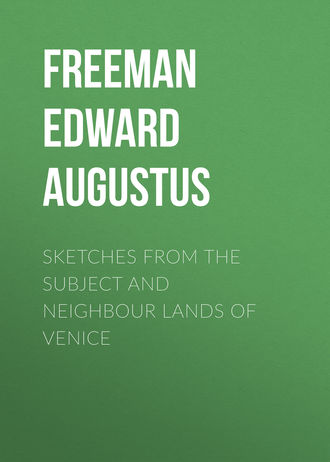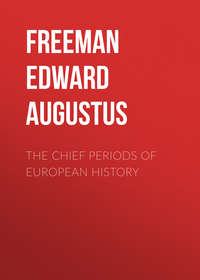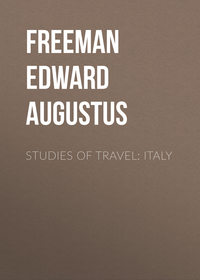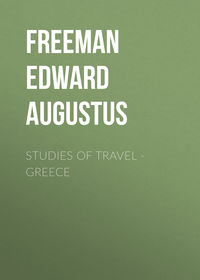 полная версия
полная версияПолная версия
Sketches from the Subject and Neighbour Lands of Venice
Treviso, so near a neighbour of Venice, the earliest of her subject cities of the mainland, does not fail to proclaim the relation between the subject and the ruling commonwealth in the usual fashion. The winged lion, the ensign which we are to follow along so many shores, appears on not a few points of her defences. Over the gate of Saint Thomas the badge of the Evangelist appears in special size and majesty, accompanied, it would seem, by several younger members of his family whose wings have not yet had time to grow. And Treviso too in some sort calls up the memory of its mistress in the abundance of streams, canals, and bridges. It has at least more right than some of the towns to which the guide-books give the name, to be called a little Venice. But the contrast is indeed great between the still waters of the lagoons and the rushing torrents which pass under the walls and turn the mills of Treviso. Venice, in short, though her name has been rather freely scattered about hither and thither, remains without likeness or miniature among either subjects, rivals, or strangers.
The heart of an Italian city is to be looked for in its town-house and the open space before it. It is characteristic of the mistress of Treviso that her palace, the palace of her rulers, not of her people, stands somewhat aside from the great centre of Venetian life. The church of the patron saint who had become identified with the commonwealth takes in some sort the place which in more democratic states belongs to the home of the commonwealth itself. Technically indeed Saint Mark's is itself part of the palace; it answers to Saint Stephen's at Westminster, not to Saint Peter's; but nowhere else among commonwealths does the chapel of the palace in this sort surpass or rival the palace itself. The less famous Saint Liberalis, patron of the city and diocese of Tarvisium, does not venture, after the manner of the Evangelist, thus to supplant Tarvisium itself. The commonwealth fully proclaims its being in the group of municipal buildings which surround the irregular space which forms the municipal centre of the city. One alone of these, at once in some sort the oldest and the newest, calls for special notice. The former palazzo della Signoria, now the palace, the centre, in the new arrangement of things, not only of the city of Treviso but of the whole province of which it is the head, has been clearly renewed, perhaps rebuilt. But it keeps the true character of a Lombard building of the kind, the simpler and truer forms which were in vogue before the Venetian Gothic set in. It marks the true position of that style that, though we cannot help admiring many of its buildings when we look at them, we find it a relief when we come to something earlier and more real. The buildings of which Venice set the type are very rich, very elegant; but we feel that, after all, England, France, Germany, could all do better in the way of windows, and that Italy left to herself could do better in the way of columns and arches. Old or new, rebuilt or simply repaired, there is nothing very wonderful in the municipal palace of Treviso; but in either case it is pleasing as an example of the genuine native style of Italy. It has arcades below, groups of round-headed windows above, and the tower looks over the palace with the more effect, because it is not parallel to it. The arcades of the palace, continued in the form of the arcades of the streets, are a feature of Treviso, as of all other southern cities that were built by rational men in rational times, and were designed, unlike Venice and Curzola, for the passage of carriages and horses. At Treviso we have arcades of all kinds, all shapes, all dates, some rude enough, some really elegant, but all of them better than the portentous folly which has offered up modern Rome and modern Athens as helpless victims to whatever powers may be conceived to preside over heat, dust, and their consequences. Treviso is not a first-class Italian city; it is hardly one of the second class; but it is pleasant to thread one's way through the arcades, to try to spell out the geography of the streams that are crossed by many bridges; it is pleasant to mount here and there on the wall, to look down on the broad foss below, and across it on the rich plain with its wall of mountains in the distance.
In the ecclesiastical department what there is of any value above ground belongs mainly to the friars. The interest of the duomo, as a building, lies wholly in its crypt, a grand and spacious one, certainly not later than the twelfth century. It may be that some of the smaller marble shafts which support its vault had already done duty in some earlier building, and there is no doubt as to the classical date of a fragment of a large fluted column which in this same crypt serves the purpose of a well. The church above has been mercilessly Jesuited; yet, as it keeps more than one cupola, those cupolas give it a certain dignity; the stamp of Constantinople and Venice, of Périgueux and Angoulême, is hard wholly to wipe out. Otherwise a few tombs and a fine piece of mediæval gilded wood-carving are about all that the church of Treviso has to show. The great Dominican church has been more lucky. The guide-book of Gsel-fels, commonly the best of guide-books, but which cuts Treviso a little short, rather sets one against it by saying that it has been wholly modernized within. Repaired and freshened up it certainly has been; but it can hardly be said to have been modernized; the old lines seem not to have been tampered with. And there is something far from lacking in dignity in the effect of its vast interior, even though its style be the corrupt Gothic of Italy. One merit is that the arches which spring from the huge pillars, though wide, are not sprawling – not like those which those who do not dare to think for themselves are called on to admire in the nave of the Florentine duomo. Unlike the work of Arnolfo, the Dominican church of Treviso does not look one inch shorter or lower than it is. It has too the interest of much contemporary painting and other ornamental work. The smaller Benedictine church hard by, whose bell-tower groups so well with Saint Nicolas, employs in that bell-tower a trefoil arch, a strange form to spring from mid-wall shafts. Within there is not much to look at, beyond a tablet setting forth the glories of the Benedictine order, how many emperors, empresses, kings, queens, popes, cardinals, archbishops, bishops, and so forth, belonged to it. Dukes, marquesses, counts, and knights, were unnumbered. It is a strange thought that to that countless band Bec added the full manhood and long monastic life of Herlwin, that Saint Peter of Shrewsbury and Saint Werburh of Chester had severally the privilege of enrolling Earl Roger and Earl Hugh, each for a few days only, as members of the brotherhood of Benedict and Anselm.
The other friars' church, that of Saint Francis, has been less lucky than its Dominican rival. Desecrated and partitioned, its inside is now inaccessible; the outside promises well for a church of its own type. Yet how feeble after all are the very best of these Italian buildings which forsook their own native forms for a hopeless attempt to reproduce the forms of other lands. We are always told that Italian Gothic cannot be Northern Gothic, because Italy is not like Northern lands. True enough; but what that argument proves is that Italy should have kept to her own natural Romanesque, the true fruit of her own soil, and should never have meddled with forms which could not be transplanted in their purity. The great fact of Italian architectural history is that the native style never was thoroughly driven out, but that, alongside of the sham Gothic, true Romanesque lived on to lose itself in the earlier and better kind of Renaissance. The open arcades of streets and houses, and the bell-towers of the churches, largely remain really Romanesque in style at all dates. For the working out of the same law in greater buildings we must make our way south-eastward. The chronicler of the eleventh century hinted that Treviso was near to Venice, and the men of the fourteenth century acted on the hint. But the wise Doge, who a generation later told his people to stick to the sea and leave the land behind, knew better where the true subject and neighbour lands of Venice lay. We cannot fully obey him as yet, as we have still points on the Italian mainland to visit. But we may still keep the true goal of our pilgrimage before our eyes, and we may remember that the lands which were most truly near to Venice were those lands, subject and hostile, to which the path lay by her own element. The lessons of which we begin to get a glimpse at Treviso we shall not learn in their fulness till we have reached the other side of Hadria.
UDINE AND CIVIDALE
1875 – 1881Ought the antiquarian traveller who has taken up his quarters at Udine and has thence made an expedition to Cividale to counsel his fellow-inquirers to follow his example in so doing or not? The answer to this question may be well made largely to depend on the state of the weather. It would be dangerous to say, from an experience of two visits only, that at Udine and Cividale it always either rains or has very lately rained; but those are the only two conditions in which we can speak of those places from personal knowledge. Now it is wonderful how a heavy rain damps the zeal of the most inquiring spirit, especially if he be carrying on his inquiries by himself. If he has companions, a good deal of wet may be shaken off by the process of talking and laughing at the common bad luck. If he be alone, every drop sticks; he has nothing to do but to grumble, and he has nobody to listen to his grumblings but himself. The land may be beautiful, but its beauties are half hid; the buildings may have the most taking outlines, but it is impossible to make a drawing of them. Even interiors lose their cheerfulness; the general gloom makes half their details invisible; and his own depression of spirit makes the inquirer less able than usual to understand and appreciate what he can see. Udine and Cividale on a fine day are something quite unlike Udine and Cividale in the rain. But even in this more cheerful state of things, when the rain has to be spoken of in the past tense, it may happen that the past puts serious difficulties in the way of the enjoyment of the present. Cividale is undoubtedly more pleasant and more profitable to see when the rain is past than when the rain is actually falling. But then, to judge from our two experiences, Cividale is easier to get at while the rain is actually falling than when it has ceased to fall. What in the one state of things is the half-dry ghiara of an Alpine stream becomes a flood covering the road for no small distance, and suggesting, to all but the most zealous, the thought of turning back. It is only those for whom the attractions of the spot which once was the Forum Julii are strong indeed, who will pluck up heart to go on when their carriage has sometimes to be helped on by men who are used to wade through the flood, or else is forced to leave what should have been the high road for a narrow and difficult path across the fields. It is well to record these things, that those who stay at home may be put in mind that, even in perfectly civilized lands, topographical knowledge is not always to be got without going to some little trouble in the search after it. We have seen Udine and Cividale wet, and we have seen them dry, but then it was when they had been wet only a very short time before. We are tempted to think that we might understand them better at some time when the rainfall was neither of the present nor of the very recent past.
One thing however is certain, that, wet or dry, not many Englishmen make the experiment of trying to find out what this corner of Italy may have to show. Not an English name, save that of one specially famous and adventurous traveller, was to be seen in the visitors' book, either in Albergo dell' Italia at Udine or in the Museum at Cividale. The true traveller is always in a doubtful state of mind when he finds a place of interest neglected by his own countrymen. On the one hand he is personally relieved, as being set free from the gabble of English tourists at tables d'hôte and the like. But how far ought he to proclaim to the world the merits of the place which he has found out for himself? How can he draw the line, so as to lead travellers to come, without holding out the least inducement to mere tourists? But perhaps the danger is not great; tourists will go only where it is the fashion to go, and the historical traveller must not think of himself more highly than he ought to think or fancy that it is for such as he to create a fashion.
We will suppose then that our traveller has started from Treviso, and has reached the frontier town of Italy in the modern sense of the name. We have seen that the existence of the place in Roman times under the name of Vedinum can be proved and no more. The importance and history of Udine, Utinum, are wholly mediæval. It takes the place of Forum Julii as the capital of Friuli the district which keeps the name which has passed away from the city. It is one of the eccentricities of nomenclature that the other Forum Julii in southern Gaul has kept its name, but in the still more corrupted shape of Fréjus. The new head of the Venetian borderland – Venetia in the older sense – went through the usual course of the neighbouring cities with one feature peculiar to itself. Not a patriarchal see, Udine was a patriarchal capital, the capital of the patriarchs of Aquileia in that temporal character which for a long while made the bishops of the forsaken city the chief princes of that corner of Italy.
Like Treviso, but somewhat later, Udine had to undergo a Hungarian siege, when the Magyar crown had passed by marriage from the house of Anjou to the house of Luxemburg. But we may mark how the different powers which had something to do with the lands with which we are concerned are already beginning to gather from the same hands. Lewis, the enemy of Treviso in 1356, purely western in origin, was purely eastern in power – King of Hungary and of the lands round about Hungary, King of Poland by a personal union. Siegmund, the enemy of Udine in 1411, was already King of Hungary, Margrave of Brandenburg also, in days when, as Hungary had nothing to do with Austria, so Brandenburg had nothing to do with Prussia. He was already chosen but not crowned King of the Romans; he was to be, before he had done, King of Bohemia, reformer of the Church, and Emperor, last crowned Emperor not of the Austrian house. Presently the city passed away from the rule of the patriarchs, but it could hardly be said to pass from a spiritual to a temporal lord when it came under the direct superiority of the Evangelist and his Lion. In the war of the League of Cambray it passed for a moment into the hands of an Austrian Archduke, but one who wore the crown of Aachen, and bore the titles of Rome without her crown. The first momentary master saw from the German Austria that Udine was Maximilian, King of Germany and Emperor-elect. In the eighteenth century the patriarchs of Aquileia had become harmless indeed, so harmless that their dignity could be altogether swept away, and their immediate province divided between the two new archbishoprics of Udine and Gorizia. Thus Udine, having once been the temporal seat of an ecclesiastical prince of the highest rank, came, as a subject city, to hold the highest ecclesiastical rank short of that which was swept away to make room for its elevation.
Udine is one of those places which keep fortifications of what we may call the intermediate period, what, in this part of the world, is specially the Venetian period. Such walls stand removed alike from those which, even when not Roman in date, closely follow the Roman type of defences, and from fortifications of the purely modern kind. The walls of Udine are well preserved and defended with ditches, and, as they fence in a large space and as there is comparatively little suburb, they form a prominent feature in the aspect of the town. Within the town, towering over every other object, is the castle or citadel, as unpicturesque a military structure as can be conceived, but perched on a huge mound, like so many of the castles of our own land. Here is work for Mr. Clark. Is the mound natural or artificial? Tradition says that it was thrown up by Attila, that he might stand on it and see the burning of Aquileia. Legendary as such a tale is on the face of it, it may perhaps be taken as some traditional witness to the artificial nature of the mound. It would be dangerous to say anything more positively without minute knowledge both of the geology and of the præ-historic antiquities of Venetia; but analogy always suggests that such mounds are artificial, or at least largely improved by art. Anyhow there the mound is, an earthwork which, if artificial it be, the Lady of the Mercians herself need not have been ashamed of.
Some of the guide-books call Udine "a miniature Venice;" it is not easy to see why. There are some canals and bridges in Udine, but so there are in Milan, Amiens, and countless other towns. There is even a Rialto; but one hardly sees how it came by its name. The true "piccola Venezia" is far away in Dalmatia, floating on its islands in the bay of Salona. The point of likeness to Venice is probably found in the civic palace and the two neighbouring columns. But these last are only the usual badges of Venetian rule, and the palace, though it may suggest the dwelling of the Doges, has no more likeness to it than is shared by many other buildings of the same kind in Italy. But, like or unlike to Venice, there is no doubt, even on a rainy day, that the palace of Udine is a building of no small merit; on a fine day it might perhaps make us say that it was worth going to Udine to see it. It is, of course, far smaller than the Doges' palace; and if it lacks the wonderful intermediate story of the Venetian building, it also lacks the ugly story above it. The point of likeness, if any, lies in the arcades, with their columns of true Italian type, slenderer than those at Venice, and using the pointed arch in the outer and the round arch in the inner range. But the columns at Udine are not a mere range like those at Venice. They stand row behind row, almost like the columns of a crypt, and they supply a profitable study in their floriated capitals. The pillared space forms the market-place of the city, and a busy place it is at the times of buying and selling, filled with the characteristic merchandise of the district, the golden balls of silk, for whose presence the Venetian land may thank the adventurous monks of Justinian's day. Some of the columns, and a large part of the rest of the building, had been renewed between 1875 and 1881. Between those years the palace had been nearly destroyed by fire. Here was a case of necessary restoration. No rational person could have been better pleased, either if the palace had been left in ruins or if it had been repaired in some incongruous fashion. In such a case as this, the new work is as much in its place as the old, and the new work at Udine is as worthy as any new work is ever likely to be to stand side by side with the old. At Udine again, as in many other places, the thought cannot fail to strike us how thoroughly these grand public palaces of Italy do but set before us, on a grand scale and in a more ornamented style, a kind of building of which a humble variety is familiar enough among ourselves. Many an English market-town has an open market-house with arches, with a room above for the administration of justice or any other public purpose. Enlarge and enrich a building of this kind, and we come by easy steps to the palace of Udine and to the palace of Venice.
The civic palace is the only building of any great architectural value in Udine. The metropolitan church contains little that is attractive for antiquity or for beauty of the higher kind. But the interior, though of mixed and corrupt style, is not without a certain stateliness, and its huge octagonal tower would have been a grand object if its upper stages had been carried up in a manner worthy of its basement. The streets are largely arcaded; and if the arcades of Udine supply less detail than those of some other Italian cities, any arcade is better than none. Udine can at least hold its head higher than modern Bari, modern Athens, modern Rome. Still at best Udine in itself holds but a secondary place among Italian cities, and its main historic interest consists in the way in which the utterly obscure Vedinum contrived to supplant both Aquileia and Forum Julii. As things now are, Forum Julii, dwindled to Cividale, has become a kind of appendage to Udine, and we must make our way thither from what is now the greater city.
Let us here put on record the memories of an actual journey, as strengthened and corrected by a later one made under more favourable circumstances. The accounts in the common guide-books are so meagre, and it is so impossible to get any topographical books in Udine, that our inquirer sets out, it must be confessed, with the vaguest notions of what he is going to see. Gsel-fels was not in those days, and, now that he has come into being, he has treated the lands at the head of the Hadriatic a good deal less fully than he has done most other parts of Italy. The traveller then is promised a store of Roman remains by one guide-book, and an early Romanesque church by another. He knows that the greatness of Forum Julii has gone elsewhere, and he is perhaps led to the belief that he is going to see a fallen city, perhaps another Aquileia, perhaps even another Salona. One thing is clear, even in the rain – namely, that the natural surroundings of Forum Julii are of the noblest kind. The grand position of the place itself he will not find out till later; but the mist half hides, half brings out, the fact that Udine lies near, and Cividale lies nearer, to the great range of the Julian Alps. Here and there their outlines can be made out; here and there a snowy peak shows itself for a moment in the further distance. A fertile plain with a mountain barrier, with broad and rushing rivers to water it – it was clearly a goodly land in which the old Veneti had fixed themselves, and in which Rome fixed the Forum of Julius as a colony and garrison to keep their land in obedience.
A long and flat road, but with the mountains ever in front, leads on by several villages with their bell-towers, over what, according to the accidents of weather, may be either a half-dry ghiara or a deep flood, till the traveller reaches the place which was Forum Julii, and which is Cividale. Here he finds himself – a little to his amazement – in a living town, with walls and gates and towers, with streets and houses and churches, none of them certainly of the Julian æra. The town is not very large; it is not a local capital like Udine; still it is a town, not a village among ruins and fragments like Aquileia and Salona. But it is plain that Cividale has not forgotten what she once was; the traveller is set down at the Grande Albergo al Friuli, and the albergo stands in the Piazza Giulio Cesare. He remembers the like name at Rimini, and he begins to cherish hopes that the treasures of Rimini may have their like at Cividale. In utter ignorance of what the place may really contain, he seeks for a bookseller's shop, hoping that some guide-book or plan of some kind may still be found. The bookseller is soon found, but his shop contains nothing of the least profit to an inquirer into the remains of Forum Julii. But the traveller hears that there is a museum; that promises something: besides the treasures which the museum itself may contain, such a place commonly implies an intelligent keeper, who sometimes proves to be a scholar of a high order. But he takes a wrong turn; no great harm however, as he thereby learns sooner than he otherwise would have learned the noble natural site of Cividale, planted on the rocky banks of the rushing stream of the Natisone. He sees two or three unpromising churches, and looks into the chief of them, a building of strange and mixed style, but not without a certain stateliness of general effect. He sees the Via Cornelio Gallo, which promises something, and the Via del Tempio, which promises more. Visions of Nîmes, Vienne, and Pola rise before him; he follows the track, but he finds nothing in the least savouring of Jupiter or Diana, and he learns afterwards that the Tempio from which the street is called is the great church, known, it seems, in a special way, as Templum Maximum. Still the museum is not reached; but a second inquiry, a second journey to quite another end of the town, leads to it. The museum is examined; it contains a considerable stock of objects of the usual kind, fragments of architecture and sculpture, which witness to the former greatness of Forum Julii. More remarkable are the specimens of Lombard workmanship, in various forms of armour and ornament, to say nothing of the actual tomb of the Lombard Duke Gisulf. At the museum he is put under the friendly guidance of a kindly priest, by whose care many matters are cleared up. Roman remains, strictly so called, there are none to see. There have been diggings, and the walls have been traced out, but all has been covered up again; outside the museum there is nothing in the pagan line left. But of Romanesque work the remains, though neither large nor many, are of high interest. Buried in an Ursuline nunnery, of which the good father opens the door, is a small Romanesque church of most singular design, built, so he tells us, in 764, but which, if so, must have received some further enrichment in the twelfth century. The sculptures in the western wall are surely of the later date; but the shell, parts of which in their coupled Corinthian columns strongly call to mind some of the ancient churches of Rome, may well be of the earlier date, of the last days of the Lombard kingdom.









